
Thunbergia alata, commonly called black-eyed Susan vine, is a herbaceous perennial climbing plant species in the family Acanthaceae. It is native to Eastern Africa, and has been naturalized in other parts of the world.

Momordica balsamina is a tendril-bearing annual vine native to the tropical regions of Africa, introduced and invasive in Asia, Australia, Central America, and North America, where they have been found in some parts of Florida. In 1810, Thomas Jefferson planted this vine in his flower borders at Monticello along with larkspur, poppies, and nutmeg.
Iliamna latibracteata is an uncommon species of flowering plant in the mallow family known by the common names California globe mallow and California wild hollyhock.
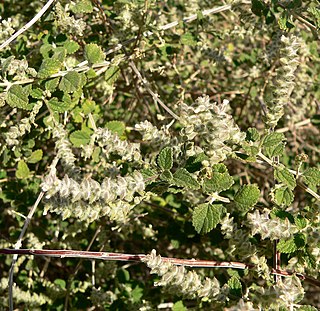
Aloysia wrightii is a species of flowering plant in the verbena family known by the common names Wright's beebrush and oreganillo. It is native to the Sonoran Desert of southwestern United States and northern Mexico, where it can be found in moist desert canyons, scrub, and woodland habitat. This is a thickly branching shrub which reaches nearly two meters in maximum height and is generally rounded in form. It has small, oval-shaped to nearly round leaves each no more than two centimeters long. The leaves have lightly toothed edges and hairy undersides. The inflorescence is a narrow, woolly spike up to 6 centimeters long, with small, widely spaced white flowers. It is a valuable nectar source for native solitary bees. It is also larval and adult food plant for the rustic sphinx moth (Manduca rustica).
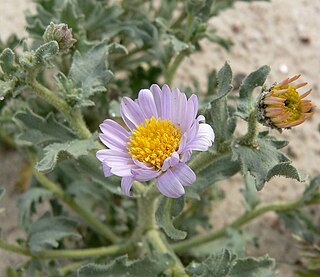
Leucosyris arida is an annual plant in the family Asteraceae, known by the common names arid tansyaster, desert tansyaster, and Silver Lake daisy. It is native to the very arid deserts of northern Mexico and the southwestern United States, and usually looks straggly and not very attractive. But in years with very heavy rainfall, it fills out and becomes rounded and bush like.

Diplacus bigelovii is a species of monkeyflower known by the common name Bigelow's monkeyflower. It is native to the southwestern United States, where it grows in desert and slope habitats. It was formerly known as Mimulus bigelovii.
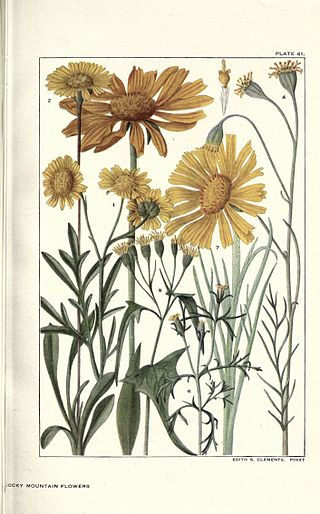
Pericome caudata is a species of flowering plant in the aster family known by the common name mountain tail-leaf. It is native to the southwestern United States as far east as Colorado, Oklahoma, and Texas, as well as northern Mexico, where it grows in rocky habitat, often in hills and mountains, and sometimes in disturbed areas. It is a large, branching, leafy perennial herb or subshrub approaching 2 meters in maximum height. It is glandular, resinous, sparsely hairy, and aromatic. The leaves are somewhat triangular, sometimes with a few large teeth or sharp lobes, the blade measuring up to 12 centimeters long and borne on a petiole. The leaf size and shape is variable across the species' range. The inflorescence is a cluster of many flower heads each under a centimeter wide and filled with golden yellow disc florets. The Navajo used this plant for a variety of medicinal and ceremonial purposes.

Petrorhagia dubia is a species of flowering plant in the family Caryophyllaceae known by the common name hairy pink. It is native to southern Europe and the Mediterranean Basin, but it is known on other continents, including Australia and North and South America, as an introduced species and sometimes a weed. It is an annual herb growing 25 to 60 centimeters tall, but known to reach 90 centimeters in height. The leaves are up to 6 centimeters long, sheathing the stem at the bases. The inflorescence bears a head-like cluster of flowers, their bases enclosed in a large, expanded mass of wide, claw-tipped bracts. The flower corollas are each further encased in a tubular calyx of sepals. The petals are bright pink to magenta or lavender in color with darker veins. Each is heart-shaped or divided into two lobes at the tip. The fruit is a capsule containing many tiny seeds.

Clerodendrum tomentosum, known as the downy chance, hairy lolly bush, hairy clairy or hairy clerodendrum is a shrub or small tree occurring in eastern and northern Australia. Distributed from Batemans Bay in southern coastal New South Wales, Queensland, Northern Territory, Western Australia, and New Guinea.

Phacelia vallis-mortae is a species of flowering plant in the borage family, Boraginaceae, known by the common name Death Valley phacelia. It is native to the southwestern United States, where it grows in deserts such as Death Valley, and mountain, plateau, and valley scrub habitat.
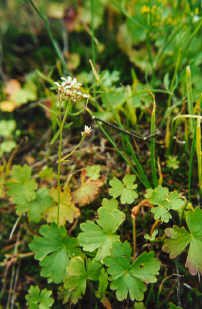
Hemieva ranunculifolia is a species of flowering plant in the saxifrage family known by the common name buttercup suksdorfia. It is the sole species in genus Hemieva. It is native to western North America from British Columbia and Alberta south to northern California. It grows in moist, rocky habitat in mountains and foothills. It is a non-rhizomatous perennial herb growing up to 40 centimeters tall. The leaves have rounded blades up to 4 centimeters wide with several large lobes edged with rounded teeth. The blades are light green, slightly fleshy, hairless in texture, and are borne on petioles up to 15 centimeters long. The inflorescence is a dense, flat-topped cluster of up to 35 flowers borne atop a mostly naked, hairy, glandular stalk. Each flower has a bell-shaped calyx of pointed sepals and five white or pink-tipped petals. The fruit is an oval brown capsule measuring 4 millimeters in length.

Trifolium obtusiflorum is a species of clover known by the common name clammy clover. It is native to California in the Peninsular, Transverse, Sierra Nevada, and the California Coast Ranges and Cascade Range into southwestern Oregon.
Tripterocalyx crux-maltae is a species of flowering plant in the four o'clock family known by the common names Lassen sandverbena and Kellogg's sand-verbena.
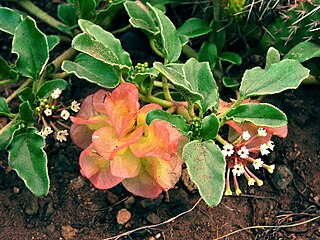
Tripterocalyx micranthus is a species of flowering plant in the four o'clock family known by the common names smallflower sandverbena and small-flowered sand-verbena.

Verbena bracteata is a species of verbena known by the common names bracted vervain, bigbract verbena, prostrate vervain, and carpet vervain. It is native to North America where it is widespread, occurring throughout the continent except for northern Canada and southern Mexico. It occurs in many types of habitat, especially disturbed areas. It typically blooms between the months of May and October. This annual or biennial herb produces several hairy, spreading stems up to 30 centimeters long forming a low mat on the ground. The hairy leaves are toothed or lobed. The inflorescence is a spike of flowers which is dense with long, pointed, leaflike bracts each up to 8 millimeters long. Each small tubular flower is about half a centimeter wide and white to pale purple in color.

Verbena lasiostachys is a species of verbena known by the common name western vervain.
Verbena menthifolia is a species of verbena known by the common name mint-leaved vervain or mint vervain. It is native to the southwestern United States and northern Mexico, where it occurs in many types of open, dry habitat such as desert scrub. This perennial herb produces one or more rough-haired, erect stems up to about 75 centimeters in maximum height. The hairy leaves are a few centimeters long and are divided near the base into a few narrow lobes which have serrated edges. The inflorescence is made up of one to three narrow, erect spikes of flowers up to 30 centimeters long. The flowers are spaced, not densely packed on the slender spike. Each flower has a small purple corolla 2 or 3 millimeters wide.

Verbena tenera, commonly known as South American mock vervain, is a species of flowering plant in the verbena family. It is native to Brazil, Argentina, and Uruguay, and it is present elsewhere as an introduced species and roadside weed. It is an annual or perennial herb producing one or more stems growing decumbent to erect in form and hairy to hairless in texture. The rough-haired leaves are divided deeply into lobes. The inflorescence is a dense, headlike spike of many flowers up to 1.5 centimeters wide. Each flower corolla is up to 1.4 centimeters wide and white to purple in color.

Abronia macrocarpa is a rare species of flowering plant known by the common name largefruit sand verbena. It is endemic to eastern Texas, where its current range is limited to Freestone, Leon, and Robertson counties. It inhabits harsh, open sand dunes on savannas, growing in deep, poor soils. It was first collected in 1968 and described as a new species in 1972. It is a federally listed endangered species of the United States.

Cirsium parryi, or Parry's thistle, is a species of North American flowering plants in the family Asteraceae. It is native to the southwestern United States, where it has been found in Colorado, Arizona, and New Mexico.

















